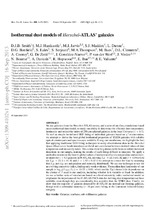| dc.contributor.author | Smith, Daniel J.B. | |
| dc.contributor.author | Hardcastle, M.J. | |
| dc.contributor.author | Jarvis, Matt | |
| dc.date.accessioned | 2016-06-29T14:11:51Z | |
| dc.date.available | 2016-06-29T14:11:51Z | |
| dc.date.issued | 2013 | |
| dc.identifier.citation | Smith, D.J.B. et al. (2013). Isothermal dust models of Herschel-ATLAS galaxies. Monthly notices of the Royal Astronomical Society, 436 (3): 2435-2453 | en_US |
| dc.identifier.issn | 1365-2966 | |
| dc.identifier.uri | http://hdl.handle.net/10566/2336 | |
| dc.identifier.uri | http://dx.doi.org/10.1093/mnras/stt1737 | |
| dc.description.abstract | We use galaxies from the Herschel-ATLAS survey, and a suite of ancillary simulations based on an isothermal dust model, to study our ability to determine the effective dust temperature, luminosity and emissivity index of 250um selected galaxies in the local Universe (z < 0.5). As well as simple far-infrared SED fitting of individual galaxies based on chi^2 minimisation, we attempt to derive the best global isothermal properties of 13,826 galaxies with reliable optical counterparts and spectroscopic redshifts. Using our simulations, we highlight the fact that applying traditional SED fitting techniques to noisy observational data in the Herschel Space Observatory bands introduces artificial anti-correlation between derived values of dust temperature and emissivity index. This is true even for galaxies with the most robust detections in our sample, making the results hard to interpret. We apply a method to determine the best-fit global values of isothermal effective temperature and emissivity index for z < 0.5 galaxies in H-ATLAS, deriving T = 22.3 +/- 0.1K and Beta = 1.98 +/- 0.02 (or T = 23.5 +/- 0.1K and Beta = 1.82 +/- 0.02 if we attempt to correct for bias by assuming that T and Beta are independent and normally distributed). We use our technique to test for an evolving emissivity index, finding only weak evidence. The median dust luminosity of our sample is log(Ldust/Lsolar) = 10.72 +/- 0.05 which (unlike T) shows little dependence on the choice of Beta used in our analysis, including whether it is variable or fixed. We use a further suite of simulations to emphasise the importance of the H-ATLAS PACS data for deriving dust temperatures at these redshifts, even though they are less sensitive than the SPIRE data. The majority of galaxies detected by H-ATLAS are normal star-forming galaxies, though a substantial minority (~31%) fall in the Luminous Infrared Galaxy category. | en_US |
| dc.language.iso | en | en_US |
| dc.publisher | Oxford University Press | en_US |
| dc.rights.uri | This is the author version of the article published in the Monthly Notices of the Royal Astronomical Society. Ther version of record ios available at http://dx.doi.org/10.1093/mnras/stt1737. | |
| dc.source.uri | http://dx.doi.org/10.1093/mnras/stt1737 | |
| dc.subject | Galaxies | en_US |
| dc.subject | Starburst | en_US |
| dc.subject | Sub-millimetre galaxies | en_US |
| dc.subject | Spectral energy distributions (SEDs) | en_US |
| dc.subject | Astrophysics | en_US |
| dc.subject | Cosmology | en_US |
| dc.title | Isothermal dust models of Herschel-ATLAS galaxies | en_US |
| dc.type | Article | en_US |
| dc.privacy.showsubmitter | FALSE | |
| dc.status.ispeerreviewed | TRUE | |
| dc.description.accreditation | Web of Science | en_US |

